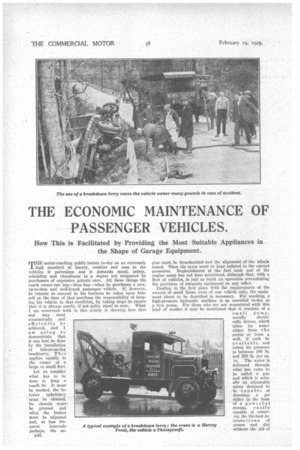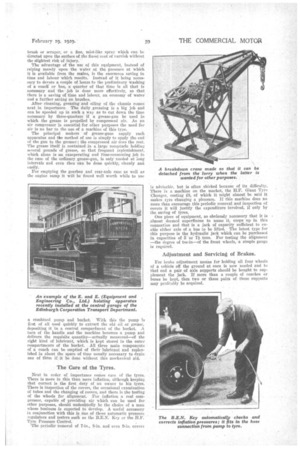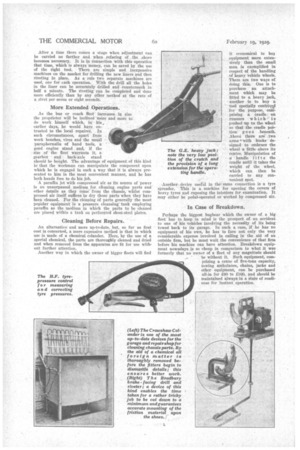THE ECONOMIC MAINTENANCE OF PASSENGER VEHICLES.
Page 148

Page 149

Page 150

If you've noticed an error in this article please click here to report it so we can fix it.
How This is Facilitated by Providing the Most Suitable Appliances in the Shape of Garage Equipment.
Tr HE motor-coaching public insists to-day on an extremely
high standard of luxury, comfort and ease in the vehicles it patronizes and it demands speed, safety, reliability and cleanliness in a degree not surpassed by purchasers of expensive private cars. All these things the coach owner can buy—does buy—when be purchases a new, up-to-date and well-found passenger vehicle. If, however, he intends to succeed in his business he takes upon himself at the time of that purchase the responsibility of keeping his vehicle in that conditiono by taking steps to ensure that it is always nearly, if not quite, equal to new. What I am concerned with in this article is showing how that end may most economically and
efficiently be achieved, and I am going to demonstrate that it can best be done by the installation of labour-saving 'machinery. This applies equally to the owner of a large or small fleet.
Let us consider what has to be done to keep a coach fit. It must be washed, the interior upholstery must be cleaned, its chassis must. be greased and oiled, the brakes must be adjusted and, at less fre
quent intervals perhaps, the enD42 give must be decarbonized and the alignment of the wheels tested. Then the tyres must be kept inflated to the correct pressures. Replenishment of the fuel tank and of the engine sump has not been mentioned, although that, with a fleet of vehicles, is just as much an operation necessitating the provision of adequate equipment as any other.
Dealing in the first place with the requirements of the owners of small fleets, even of one vehicle only, the equipment about to be described is necessary. For washing, a high-pressure hydraulic machine is as essential to-day as a tyre pump. For those who are not acquainted with this kind of washer it may be mentioned that it consists of a
small pump,
usually eleetrically driven, which takes its water either from t It e mains or from a well, if such be available, and raises its pressure to between 300 lb. and MO lb. per sq. in. The water is, delivered through what has come to be called a gun and which is actually an adjustable spray designed to be capable of directing a jet either in the form of a powerful stream, easily capable of removing the thickest incrusta tion s of grease and dirt without the aid of
bruah or scraper, or a fine, mist-like spray which can be directed upon the surface of the finest coat of varnish without the slightest risk of injury.
The advantage of the use of this equipment, instead of relying merelY upon the water at the pressure at which it is aVailable. from the mains, is the enormous saving in time and labour which results. Instead of it being necessary to devote a couple of hours.to the preliminary washing of a -coach' or bus, a quarter of that time is all that is necessary and the . job is done more effectively, so that there is a saving of time and labour, an economy of water and a further saving on brushes.
After cleaning, greasing and oiling of the chassis conies next in importance: The daily greasing is a big jab and can be speeded. up in such a way as to cut down the time necessary by three-quarters if a grease-gun be used in which. the grease is Propelled by compressed air. As an air compressor is essential for other purposes the need for air is no bar to the use of a machine of this type.
The principal makersof grease-guns supply such apparatus mid the method of use is simply to apply the end of the gun to the greaser ; the compressed air does the rest. The grease itself is contained • in a large receptacle balding several ,pounds of grease, so that frequent replenishment, which alone is -a,u exasperating and time-consuming job in the case of the ordinary.g-rease-gun, is only needed at iong intervals and even then can be done quickly; cleanly and
easily. • For emptying the gearbox and rear-axle case as well as the engine sump it will be fmind well Worth while to use
a combined pump and bucket. With this the pump is first of all used quickly to extract the obi oil or grease, depositing it in a central compartment of the bucket. A turn of the handle and the machine becomes a pump and delivers the requisite quantity—actually measured—of the right kind of lubricant, Which is kept stored in the outer compartments of the bucket. All three main components of a coach can be emptied of their lubricant and replenished in about the space of time usually necessary to drain one of OM if it be done. without this mechanical aid.
The Care of the Tyres.
Next in order of importance comes care of the tyres. There is more in this than mere inflation,although keeping that correct is the first duty of an -owner to his -tyres. There is inspection of the covers, the occasional examination of tubes and the changing of covers, and there is the testing of the wheels for alignment. For inflation a real compressor, capable of providing air which ran be used for other purposes, should undoubtedly be the choice of a man whose business is expected to develop. A useful accessory in conjunction with this is one of those automatic pressure regulators and testers such as the B.E.N.Key or the 14.P. Tyre Pressure Control, 'The periodic removal of 7-in., S-in, and even 0-in. Covers
is advisable. but is often shirked because of its difficulty. There is a machine on the market, the U.F. Giant Tyre Changer, costing £8, of which it might almost be said it makes tyre changing a pleasure. If this maChine does no more than encourage, this periodic removal, and inspection of covers it will justify the expenditure involved, if only by the saving of tyres. One piece of equipment, so obviously necessary that it is almost deemed superfluous to name it, crops up in this connection and that is a jack of capacity sufficient to enable either axle of a bus to be lifted. The latest type for this purpose is the hydraulic jack which can be purchased in capacities of 5 or 73...tons. For testing the alignment • —the degree of toe-in—of the front wheels, a simple gauge is required.
Adjustment and Servicing of Brakes.
For brake adjustment means for holding all four wheels of a vehicle off the ground at once is now needed and to that end a pair of axle supports should be bought to supplement the jack. If more than a couple of coaches or buses be kept, then two or three pairs of these Supports may profitably be acquired. After a time there comes a stage when adjustment can be carried no farther and when _refacing of the ,shoes becomes necessary. It is in connection with this operation that time, which is always money, can be saved by the use of the right tool. There are simple and inexpensive machines on the market for drilling the new liners and then riveting in place. As a 'rule two separate machines are used, one for Each operation. With the drill all the holes in the liner can be accurately drilled and countersunk in half a minute. The riveting can he completed and done more efficiently than by any other method at the rate of a rivet per seven or eight seconds.
• More Extended Operations.
As the bus or coach fleet increases in size the proprietor will be inclined more and -more to do work himself which, in his earlier days, he would have entrusted to the local repairer. In such circumstances, apart from work benches, vices and the usual paraphernalia of hand tools, a good engine stand_ and, if the size of the fleet warrants it, a gearbox • and back;axle stand
should be bonght. The advantage of equipment of this kind is. that the Workman can manipulate the component upon which he is engaged in such a way that it is always presented to him in the most convenient manner, and he has both hands free to do his job.
'A paraffin jet with compressed air as its source of power is an unsurpassed medium for creaning engine parts and other details as they come. from the chassis, whilst compressed air itself suffices to dry those parts when they have been cleaned. For the cleaning of parts generally the most popular equipment is a pressure cleansingtank employing paraffin as the medium in which the parts to be cleaned are placed within a tank on perforated sheet-steel plates.
Cleaning Before Repairs.
An alternative and more up-to-date, but, so far as first cost is concerned, a more expensive method is that in which use is made of a chemical colander. Here, by the use of a special chemical, the parts are thoroughly cleaned and dried and when removed from the apparatus arc fit for use without further attention.
Another way in which the owner of bigger fleets will find
it economical to buj equipment more extensively than the small mini is exemplified in respect of the handling of heavy vehicle wheels. There are two ways of doing this. One is to purchase an attachment which may be fitted to a heavy jack, another is to buy a tool specially contrived for the purpose, coinprising a cradle on runners which is Pushed up to the wheel so that the cradle poitiowgoei .beneath. Above there are two arms e with hooks designed to embrace the wheel a little above its centre. Manipulation of a beadle lifts the cradle until it takes the weight of the wheel, which can then be carried to any convenient spot.
Another device useful in thesame connection is a tyre spreader. This is a machine for opening the covers of heavy tyres and exposing the interiors for examination. It may either be pedal-operated or worked by compressed air.
In Case of Breakdown.
Perhaps the biggest bugbear which the owner of a big fleet has to keep in mind is the prospect of an accident to one of his vehicles involving the necessity of its being towed back to its garage. In such a case, if he has DO equipment of his own, he has to face not only the very considerable expense involved in calling in the aid of an outside firm, but he must wait the convenience of that firm before his machine can have attention. Breakdown equipment nowadays is so cheap in comparison to what it was formerly that no owner of a fleet of any magnitude should be without it. Such equipment, comprising a crane of five-tons capacity, towing ambulance, chains, jacks and other equipment, can be purchased all-in for £80 to f100, and should be maintained always in a state of readiness for instant operation.




























































































































































































































